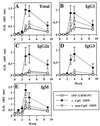CpG oligodeoxynucleotides act as adjuvants for pneumococcal polysaccharide-protein conjugate vaccines and enhance antipolysaccharide immunoglobulin G2a (IgG2a) and IgG3 antibodies
- PMID: 10678959
- PMCID: PMC97300
- DOI: 10.1128/IAI.68.3.1450-1456.2000
CpG oligodeoxynucleotides act as adjuvants for pneumococcal polysaccharide-protein conjugate vaccines and enhance antipolysaccharide immunoglobulin G2a (IgG2a) and IgG3 antibodies
Abstract
Pneumococcal polysaccharide-protein conjugate vaccines elicit antipolysaccharide antibodies, but multiple doses are required to achieve protective antibody levels in children. In addition, the immunogenicity of experimental multivalent pneumococcal conjugate vaccines varies with different polysaccharide serotypes. One strategy to improve these vaccines is to incorporate an adjuvant to enhance their immunogenicity. Synthetic oligodeoxynucleotides containing unmethylated CpG motifs (CpG ODN) are adjuvants that promote T-cell and T-dependent antibody responses to protein antigens, but it has been unclear whether CpG ODN can enhance polysaccharide-specific antibody responses. The present studies demonstrate significant adjuvant activity of CpG ODN for antibody responses against Streptococcus pneumoniae polysaccharide types 19F and 6B induced by conjugates of 19F and 6B with the protein carrier CRM(197). BALB/c ByJ mice were injected with 19F-CRM(197) or 6B-CRM(197) with or without CpG ODN, and sera were tested for anti-19F or anti-6B antibodies by enzyme-linked immunosorbent assay. The polysaccharide-specific antibody response to 19F-CRM(197) alone was predominantly of the immunoglobulin G1 (IgG1) and IgM isotypes, but addition of CpG ODN markedly increased geometric mean titers of total anti-19F antibody (23-fold), anti-19F IgG2a (26-fold), and anti-19F IgG3 (>246-fold). The polysaccharide-specific antibody response to 6B-CRM(197) alone consisted only of IgM, but addition of CpG ODN induced high titers of anti-6B IgG1 (>78-fold increase), anti-6B IgG2a (>54-fold increase), and anti-6B IgG3 (>3,162-fold increase). CpG ODN also increased anti-CRM(197) IgG2a and IgG3. Adjuvant effects were not observed with control non-CpG ODN. Thus, CpG ODN significantly enhance antipolysaccharide IgG responses (especially IgG2a and IgG3) induced by these glycoconjugate vaccines.
Figures




References
-
- Adams W G, Deaver K A, Cochi S L, Plikaytis B D, Zell E R, Broome C V, Wenger J D. Decline of childhood Haemophilus influenzae type b (Hib) disease in the Hib vaccine era. JAMA. 1993;269:221–226. - PubMed
-
- Askew D, Chu R, Krieg A, Harding C V. CpG DNA and LPS cause dendritic cell (DC) maturation with distinct effects on nascent and recycling MHC-II antigen processing. FASEB J. 1999;13:A279. - PubMed
-
- Briles D E, Claflin J L, Schroer K, Forman C. Mouse IgG3 antibodies are highly protective against infection with Streptococcus pneumoniae. Nature. 1981;294:88–90. - PubMed
Publication types
MeSH terms
Substances
Grants and funding
LinkOut - more resources
Full Text Sources
Other Literature Sources

